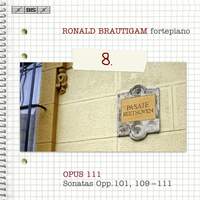Recording of the Week,
Ronald Brautigam's Beethoven
This week sees the release of the final volume in Ronald Brautigam’s cycle of Beethoven’s Piano Sonatas on a fortepiano.
The period in which Beethoven wrote these sonatas was one of rapid development for the piano (or fortepiano as it was then called) and he more than anyone pushed the manufacturers by constantly writing music slightly beyond the natural capabilities of the instruments of the time. For this recording of four of the late sonatas, Brautigam uses a fortepiano built in 2007 by Paul McNulty modelled on an instrument by Conrad Graf of about 1819. Graf was an important maker of the time and in 1825 provided a piano for Beethoven. His instruments retained the thin soundboard and light hammers typical of the Viennese classical era and he was held in high esteem by a number of composers including Chopin, Schumann and Brahms.

Although the fortepiano is in some respects a smaller version of a modern piano, there's nothing small-scaled about these performances. And while the fortepiano doesn’t have the same power and volume as a modern concert grand, it more than makes up for that in clarity and timbre. The fact that you can actually hear all the notes in the fortissimo low passages gives it a frightening ferocity. Indeed I think one of the big drawbacks of using a modern piano to play Beethoven is that the loud low passages often descend into a muddy haze. There is no such danger here and the rapid and repeated low notes build this music into a real frenzy of excitement.
Other than the increased clarity, the other very noticeable thing on these recordings is that different registers on the fortepiano all have slightly different timbres. This gave Beethoven an extra reason to score passages in certain registers and gives Brautigam a much wider palette of colours at his disposal. It means he doesn’t need to use other techniques (like rubato and variety of attacks) in order to characterise phrases differently, and this increased simplicity is very much to the benefit of the music. In Brautigam’s hands the music sounds lyrical and perfectly phrased without in any way sounding mannered.
Because the fortepiano doesn’t have the same sustaining power as a modern piano Brautigam’s tempos for the slower movements are often slightly faster than you might be used to. But they never sound rushed, and always feel natural, while giving him the opportunity for a little ebb and flow without danger of losing the musical line.
The recording was made in Österåker Church in Sweden which has a rich and sympathetic acoustic. It suits the instrument well as it softens the percussive edge and makes it sound probably richer than it actually is. If I’m honest I might have preferred a more neutral acoustic (more akin to drawing rooms and small halls that one imagines Beethoven would probably have played these sonatas), but you can’t get away from how good it all sounds so it is very hard to complain. The recorded sound is otherwise vibrant and realistic and it sounds superb in SACD but equally marvellous in conventional two-speaker stereo.
The mixture of Brautigam’s technique, insights and musicality combined with the clarity and excitement of the fortepiano makes a very strong case for this whole series. I’m told that although he has now completed the 32 numbered sonatas he plans to go on and record the Early Bonn Sonatas and the variations, dances and bagatelles. And while I certainly wouldn’t want to only ever listen to Beethoven on a fortepiano, I do think that to really understand his piano music you need to know something about the instruments he wrote for, and you’re missing out on something in this music if you have only ever heard it played on modern instruments.
As usual I’ve given you a couple of samples to give you an idea. Enjoy!
Ronald Brautigam (fortepiano)
Available Formats: SACD, MP3, FLAC, Hi-Res FLAC



